
|   |

|   |
A week-long sojourn of serenity and spirituality - Manjari Sinha e-mail: manjari@sinha.com Photos courtesy: Spic Macay June 27, 2023 The luminous legacy of Indian classical music and dance, art, and culture, resonated vibrantly amongst the congregation of 1300 youth from all over the country and outside who had come for the 8th International Convention of SPIC MACAY (Society for Promotion of Indian Classical Music and Culture Amongst Youth), at the Visvesvaraya National Institute of Technology (VNIT), Nagpur. The ashram like schedule started at 4 in the morning with Hatha Yoga, Nada Yoga, and Koodiyattam practices, intensive workshops and performances of classical and folk music and dance, arts and crafts to classic film screening followed by discussions with director/actor, Qawwali, Gurubani to the Western choir and more, offered a sojourn of serenity and spirituality for the participating delegates and art lovers gathered at the lush green campus of VNIT, Nagpur from May 29-June 4, 2023.  Dr.N Rajam and her granddaughter Nandini Shankar  Dr.Prabha Atre Heralded with the auspicious music of the nadaswaram by Sheik Mehboob Subhani and Kaleeshabi, the S.M. International Convention was inaugurated by Dr. Vinay Sahasrabuddhe, D.G. ICCR in the august presence of Dr. Krishna Kumar, V.C. Amrita University Kochi, Kanchan Gadkari and the gracious host Dr. Pramod Padole, Director VNIT. The message from Prime Minister Modi was read out by R.M. Tiwari, National Chairperson of SPIC MACAY before the mesmerizing inaugural concerts of violin recital by the 87 years young Dr. N. Rajam and vocal by Dr. Prabha Atre at 90 took the audience to the blissful heights of Indian classical music. "Listening is an art, which has to be cultivated consistently. It demands patience and grows slowly like a flower," said Dr. Prabha Atre before presenting raga Madhur-Kauns, her own creation. She applauded Dr. Kiran Seth, the founder of Spic Macay who has been striving towards inculcating sanskara and the values of our culture in youngsters through listening and watching intently by taking our classical and folk arts to schools and colleges for more than four decades. The week-long convention proved her point beyond measure.  Rajat Kapur in conversation  Ustad Wasifuddin Dagar (Pic: Manjari Sinha) The classical concerts by stalwarts of music and dance every evening climaxed with an overnight concert featuring mridangam Vidwan Umayalpuram K. Sivaraman, Pt. Ulhas Kashalkar, A. Kanyakumari (Carnatic violin), Pt. Sajan Mishra, Vidwan D. Sheshachari, and Ustad Wasifuddin Dagar (Dhrupad) from dusk to dawn on the concluding day of the week-long fare of sumptuous spread of soul-stirring performances. The afternoon sessions of film screening had a discussion with Rajat Kapur after the screening of 'Making of Mahatma', and with Adoor Gopalakrishnan about the film 'Images - Reflection' on him and its director Girish Kasarvalli. Pung Cholam by Guru Keerti Singh and his troupe from Imphal, Manipur, gave a sense of piety with the performers dressed in crisp white dhoti and sapha (turban), holding and playing Pung, the percussion instrument, and dancing all at once. The stage felt like the pious courtyard of the famous Govindaji Temple with this ritualistic dance performed with devotional fervour.  Pung Cholam (Pic: Manjari Sinha)  Gurbani Dr. Alankar Singh created the reverential aura of Gurbani right from the opening aalap in the afternoon raga Bhimpalasi on the melodious Dilruba played by Sandip Singh. This raga is mentioned as Dhanashri in Guru Granth Sahib, explained Alankar Singh, before presenting the Sabad. This Sabad had the flavour of all, the Dhrupad, Khayal and Thumri. This was superbly brought in by Alankar Singh supported by Narendra Pal Singh on tabla, playing Padtal which was a combination of Chautal (for Dhrupad), Drut Ektal (for Khayal) and Deepchandi (for Thumri), combined together!  Warsi Brothers The renowned Warsi Brothers from Hyderabad gave a refreshing touch to their Qawwali repertoire from the very beginning when they opened with 'Wahe Ali,' a Qaul of Amir Khusro and the adjoining Tarana, instead of the oft-repeated "Mann kunto maula..." normally sung to open a Qawwali program. The next piece "Chain tumse qaraar tumse..." was composed in a rare raga, like Gorakh Kalyan, which proved their classical music background. The young listeners wanted more even after the closing Bhairavi "Bekhud kiye dete hain", hence Warsi Brothers had to sing "Aaj rang hai" the popular 'Rang' of Amir Khusro. 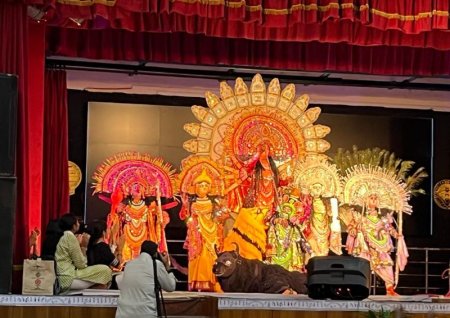 Purulia Chhau (Pic: Manjari Sinha) 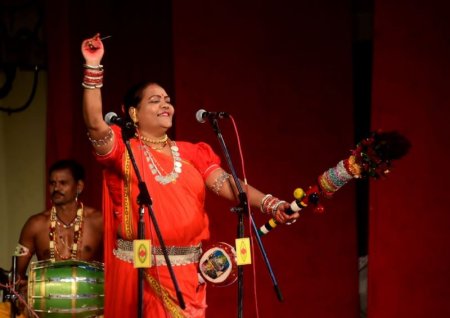 Pandavani by Usha Barle 'Mahishasura Mardini', the folk ballet in Purulia Chhau was presented by Taradad Rajak and his troupe. The fight scenes between the lion of Devi Durga and the Mahish (buffalo) of Mahishasura, attracted children with their colourful costumes and acrobatic choreography. Pandavani by Usha Barle had all the verve and valor for the mighty epic characters she personified in her ekaharya abhinaya playing multiple characters enacting stories from Ramayana and Mahabharata. Maharashtrian folk music 'Pavara' by Shahir Vijay Pande and party, Kabir Gayan by Prahlad Singh Tipanya aur Saathi, Choir by Neemrana Music Foundation; there was no end to the fascinating variety of performances in the afternoon sessions. The fabulous puppet show 'Rumi' by Dadi Padumji and Gomeyetta by Bhaskar Kogga Kamath was the added attractions of puppetry too. 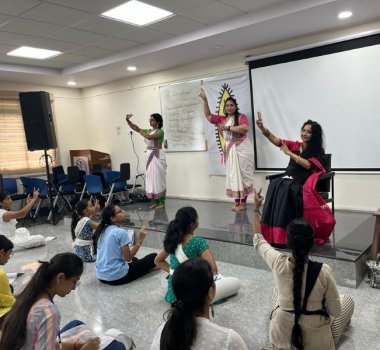 Gopika Varma (Pic: Manjari Sinha) 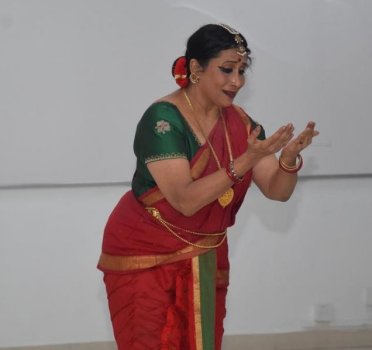 Vyjayanthi Kashi The morning sessions of intensive workshops involved Gurus like Dr. Prabha Atre (Hindustani vocal), Ud Wasiffudin Dagar (Dhrupad), Dr Sheshachari (Carnatic vocal), Lalgudi GJR Krishnan (Carnatic Violin), Meenakshi Chitharanjan (Bharatanatyam), Vyjayanthi Kashi (Kuchipudi), Prerana Shrimali (Kathak), Gopika Varma (Mohiniyattam), Sujata Mohapatra (Odissi), Margi Madhu (Koodiyattam) and Guru Ghanakanta Bora (Sattriya). Students also learned Hatha Yoga under Swami Thyagaraj, meditation under Brahmakumari Maneesha, Pandavani - Usha Barle, Pung Cholam- Keerti Singh, Gurbani - Dr. Alankar Singh and Puppetry under Dadi Padumji.  Hatha Yoga workshop 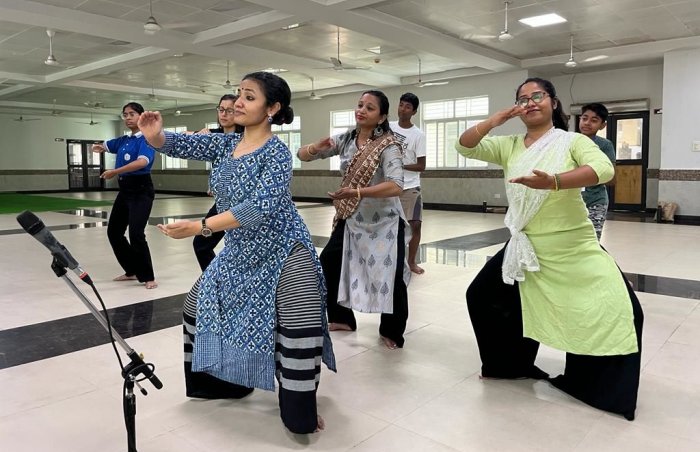 Sattriya workshop led by Anwesa Mahanta It was interesting to watch these Gurus teaching totally novice, uninitiated boys and girls the intricacies of our arts. Gopika Varma for instance, teaching hand gestures along with Sanskrit shlokas from Hastalakshana Deepika also told them, "No mudra is complete without your facial expressions. Moon is up there, so you look up and your eyebrows praise its beauty. A mudra gets its meaning when the body movements and facial expressions go with it." Similarly, the Kuchipudi Guru Vyjayanthi Kashi made the young students sit and explained the reference and meaning of the sahitya before teaching them the Krishna Devaraya Shabdam. Sujata Mohapatra regaled the audience with an Odissi dance performance on the penultimate evening. Opening with Mangalacharan in raga Gurjari Todi and triputa tala invoking Krishna and Shankarabharanam Pallavi by her ace disciple Saumya Murty, she proceeded to Jayadeva's ashtapadi "Sakhi he..." before presenting the time-tested choreography of her Guru Kelucharan Mohapatra's 'Ramayan', with lyrics by Kavisurya Upendra Bhanja, composed by Pt Bhubaneswar Mishra. Her involved ekaharya abhinaya enacting all the characters in the epic story from Rama, Lakshmana, and Seeta, to the golden deer, Ravan, Jataayu et al encompassing scenes from Panchavati to Seeta-Haran and Jatayuvadha Prasang got her a standing ovation 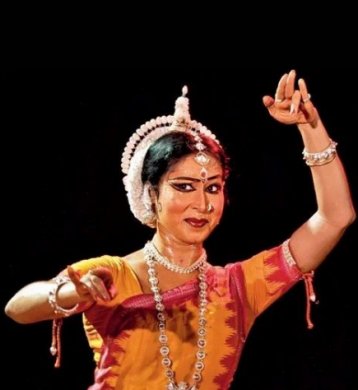 Sujata Mohapatra 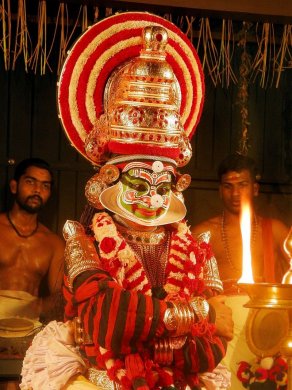 Margi Madhu Chakyar Nepathya Centre for Excellence in Koodiyattam presented a riveting performance by Margi Madhu Chakyar as Ravana. It was an engaging sequence from 'Ashokavanikaankam,' the 5th Act from the play Ascharya Chudamani written by Shaktibhadra. Ravana is thinking about the beauty of Seetha after dragging her from the forest and imprisoning her in the Ashoka Vatika. In a 'nakha shika varnan' of her beauty, he starts praising the beauty of her Panchangas, five angas starting from hair to eyes, face, breast, and feet. Ravana enacts in detail how her hair has defeated the beauty of the jealous peacock feather and honoured by Brahma along with the detailed story behind it. The powerful support on mizhavu by Kalamandalam Manikandan, edakka by Dinesh Warrier, and talam by Dr Indu G created the most appropriate sound effects augmenting the desired emotions expressed so eloquently by Margi Madhu Chakyar. The week-long Intercon was an enriching opportunity for art lovers and also quite fascinating for the young delegates from faraway places, who were perhaps witnessing and experiencing these vibrant art forms, and rare instruments like Rudraveena or Dilruba and a Koodiyattam performance for the first time in their life. 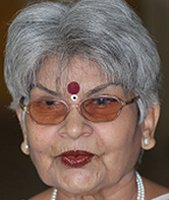 Manjari Sinha has an M.A. in Sanskrit and Music, and trained in vocal, tabla, sitar and Kathak dance. She has regular columns in national dailies as a music and dance critic. |